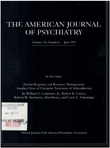Community patterns of psychiatric disorders after the Exxon Valdez oil spill
Abstract
OBJECTIVE: This study examined the relationship between exposure to the Exxon Valdez oil spill and subsequent cleanup efforts and the prevalence of generalized anxiety disorder, posttraumatic stress disorder (PTSD), and depressive symptoms in 13 Alaska communities. METHOD: A community survey of 599 men and women was conducted approximately 1 year after the spill occurred. Questions from the National Institute of Mental Health Diagnostic Interview Schedule were used to assess symptoms of generalized anxiety disorder and PTSD. The Center for Epidemiologic Studies Depression (CES-D) Scale was used to assess levels of depressive symptoms. RESULTS: The post-spill (i.e., 1- year) prevalence of generalized anxiety disorder and PTSD for the study communities with all degrees of exposure was 20.2% and 9.4%, respectively. The prevalence of respondents with CES-D Scale scores above 16 and 18 was 16.6% and 14.2%, respectively. When compared with the unexposed group, members of the high-exposure group were 3.6 times as likely to have generalized anxiety disorder, 2.9 times as likely to have PTSD, 1.8 times as likely to have a CES-D Scale score of 16 and above, and 2.1 times as likely to have a CES-D Scale score of 18 and above. Women exposed to this event were particularly vulnerable to these conditions, and Alaska Natives were particularly vulnerable to depressive symptoms after the oil spill. CONCLUSIONS: The results suggest that the oil spill's impact on the psychosocial environment was as significant as its impact on the physical environment. The Exxon Valdez experience suggests a number of implications for the mental health needs of disaster victims, particularly in primary care settings.
Access content
To read the fulltext, please use one of the options below to sign in or purchase access.- Personal login
- Institutional Login
- Sign in via OpenAthens
- Register for access
-
Please login/register if you wish to pair your device and check access availability.
Not a subscriber?
PsychiatryOnline subscription options offer access to the DSM-5 library, books, journals, CME, and patient resources. This all-in-one virtual library provides psychiatrists and mental health professionals with key resources for diagnosis, treatment, research, and professional development.
Need more help? PsychiatryOnline Customer Service may be reached by emailing [email protected] or by calling 800-368-5777 (in the U.S.) or 703-907-7322 (outside the U.S.).



